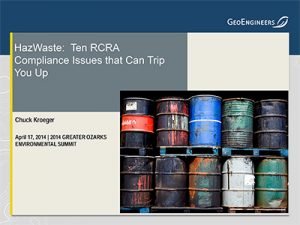GeoEngineers Designs First Successfully-Completed US Direct Pipe® Installation Under a Levee
GeoEngineers is pleased to announce the successful completion of the first Direct Pipe® crossing of a US Army Corps of Engineers (USACE)-regulated levee. The 48-inch-diameter pipeline stretches for more than a half-mile crossing under the Sabine Neches Waterway and the levee and railroad tracks in Port Arthur, Texas. It will bring water from Port Arthur […]
Engineers and Scientists, Unlock Your Inner Artist
It was recently brought to my attention (I feel late to the game) that “Art” was added last year to educational curricula focused on Science, Technology, Engineering and Mathematics (STEM), creating a sub-group called STEAM. This is fantastic news. As both an artist (guitarist) and a scientist (geology), I believe when you connect engineering and […]
Ten RCRA Hazardous Waste Compliance Issues
The federal Resource Conservation and Recovery Act (RCRA) sets regulations to: Protect human health and the environment from the potential hazards of waste disposal Conserve energy and natural resources Reduce the amount of waste generated Ensure that wastes are managed in an environmentally sound manner Many people who work in environmental management or with natural […]
GeoEngineers Puts Whales on the Map – Literally
GeoEngineers’ technology team created an interactive whale-tracking map of the waters surrounding Hawaii that has received national attention this past week, including being named WIRED magazine’s “Science Graphic of the Week.” Other publications such as Huffington Post, Gizmodo, Fast Company, and local Hawaiian news channel KITV have done stories about the map, calling it “hypnotically beautiful.” […]
The Story Behind Canada’s First Avian Protection Plan
A few months ago I had the pleasure of meeting Nikki Heck, an environmental advisor for AltaLink, at the Avian Power Line Interaction Committee conference in Cape May, NJ. In the video above, she tells the story of how she came to introduce the first avian protection plan in Canada on behalf of AltaLink, Alberta’s […]
How Data Collection Can Help Prevent Costly Power Outages
As we move further into autumn and large flocks of birds start migrating south for the winter, the risk for power outages increases. Birds and other wildlife are the third leading cause of power outages in the US, something electric utilities can’t afford when temperatures dip. There was a compelling presentation recently about this topic […]
Spokane Office Laboratory Receives A2LA Accreditation
GeoEngineers’ concrete and soil/materials lab in Spokane, WA, received another two years of accreditation by the American Association of Laboratory Accreditation (A2LA). A2LA—a nonprofit, non-government, public service, membership society—is one of the leading accreditation bodies in the construction materials and special inspection and testing industry. A2LA accreditation is based on internationally accepted criteria for competence […]
The New Guidelines for Drafting Avian Protection Plans
An avian protection plan, also known as an APP, is a voluntary, utility specific plan for reducing risks to birds and system reliability that result from avian interactions with power lines and electric utility facilities. In 2012, the Avian Power Line Interaction Committee updated these guidelines, which were originally drafted in 2005. If you have […]
Wind Turbines and Bird Mortalities: How to Accurately Track and Report Data
A recent Associated Press article on the number of eagles killed by wind farms in the last five years has been widely circulated among major media outlets, such as NBC News, ABC News, The Weather Channel, and multiple newspapers. The article, and the study it cites, highlights the importance of accurately tracking and reporting bird […]
Emergency Response Considerations That Go Beyond Geology
I recently talked about landside emergency response procedures for the American Public Works Association’s (APWA) Washington Chapter Emerging Professionals Committee. The original request was to focus on the Whidbey Island landslide that occurred this spring. However, considering the audience, I thought it would be more helpful to incorporate discussions of other emergency-response scenarios I’ve encountered […]

